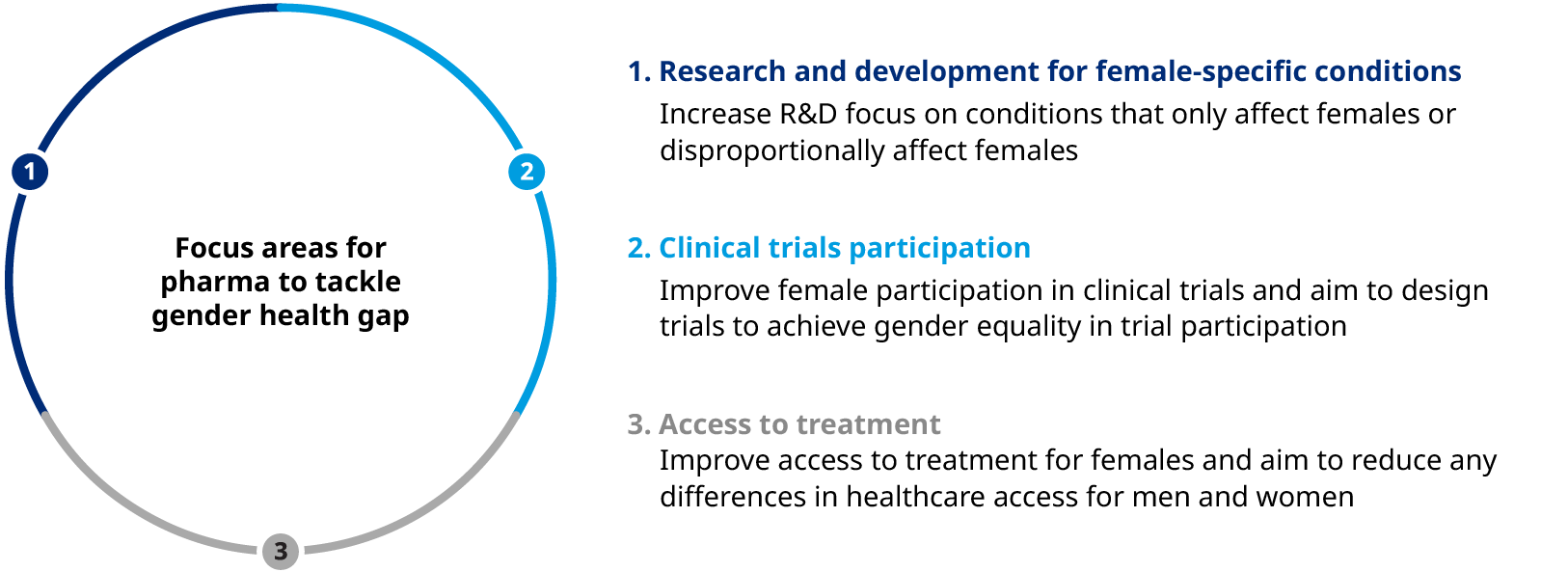This article is part of an ongoing series exploring how pharmaceutical companies can impact and help reduce health inequities. Discover more insights from our first article.
The gender health gap is real. Although women have a longer life expectancy than men, they often experience worse health outcomes. Women are more likely to suffer from chronic pain. And due to biases suggesting that they are oversensitive to pain, women are less likely to be prescribed painkillers, instead being advised to seek psychological treatment. Women are diagnosed later than men for more than 700 diseases, including six non-specific types of cancer. And women have a 20% higher chance of developing heart failure or dying within five years of their first heart attack than men.
As we outlined in the first article in this series, there are numerous reasons why health inequities persist across age, gender, and race demographics. For the pharmaceutical industry, we identified three areas where companies can and should have a significant impact: expanding medical and scientific knowledge, reducing bias at the bedside, and tackling social barriers. In this article, we take a closer look at how pharmaceutical companies can move the needle on closing the gender health gap.
Increasing Women’s Representation in Research
Adhering to the adage “follow the money,” one clear reason for the gender health gap is the decades-long underfunding of women’s health issues. An oft-cited statistic from Forbes suggests that women’s health accounts for just 4% of research and development funding on healthcare products and services. Yet an analysis of US data found that healthcare spending for women aged 44 to 64 was 24% higher than for men. For women 18 to 44, spending was 84% higher; childbirth was a factor in this age cohort.
The spending gap applies not only to female-specific conditions, but conditions where women are disproportionally impacted. An analysis of federal spending in the US found that twice as much funding goes to diseases that disproportionally affect men compared to those that mainly impact women. Another analysis showed that only 12% of the National Institutes of Health’s external research portfolio for Alzheimer’s Disease is allocated to understanding women’s health, yet roughly two-thirds of Americans suffering from the disease are women. And just 4.5% of funding for coronary artery disease is targeted at women, even though cardiovascular disease is the leading cause of death in women and 45% of women 20 years or older are living with some form of cardiovascular disease.
The underfunding hasn’t occurred in a vacuum. It wasn’t until 1993 when US lawmakers mandated women and racial and ethnic minorities be included clinical trials. Despite regulatory and policy updates over the years, women, as well as minorities, continue to be underrepresented in clinical trials, especially in phases 1 and 2.

The gender gap continues to reach deep into the policy-making realm. Globally, women made up just 24% of COVID-19 governmental task forces and advisory boards.
These limitations have real-world implications. Researchers at UC Berkely and the University of Chicago found that women suffer more adverse reactions to medications than men. That’s because most drug dosing guidelines are based on male-dominated clinical trials. Adverse drug events pose a significant problem to healthcare systems around the world. They account for as much 18% of hospital admissions in Australia, while up to 20% of ambulatory patients in Europe suffer an adverse drug event. In the US alone, adverse reactions cost the healthcare system $30 billion annually. Including more women in clinical trials would improve the industry’s medical knowledge and go a long way towards improving safety, along with alleviating the economic burden.
Pharma’s Opportunity
Pharmaceutical companies can help the industry make sizeable strides in reducing health inequities by tackling the gender health gap through three key areas:

It starts with a commitment at the top to ensure that women’s health becomes a core part of the business’ strategy rather than a peripheral division isolated from corporate priorities. Many pharmaceutical companies have already begun tackling women’s health and have established dedicated research and development divisions. But efforts will fall flat unless women’s health is integrated and prioritized across the entire product lifecycle. Pharma’s commitment to women’s health needs to be put in practice by translating strategic objectives into a clear roadmap for implementation and defining key performance indicators to measure success. Beyond this, pharma needs to ensure that women’s health teams do not work in silos. This means increasing cross-functional and cross-product collaboration by engaging with commercial and market access colleagues early on, as well as anchoring women’s health into the R&D infrastructure. As they engrain women’s health across the company’s culture, leaders should also celebrate successes as a collective.
Addressing female representation in clinical trials is another important area that needs attention. Many pharmaceutical companies have committed to increasing the number of women participating in trials. Building the infrastructure to achieve gender diversity in trials takes time and requires more than just making a strategic commitment. Companies that are successful on this front carefully design their trial inclusion criteria and logistics, partner with different organizations, and ensure the clinical trial sites have the right mechanisms and staff in place to support female participants.

The work doesn’t stop at the research and development stage. Once medications are approved, pharmaceutical companies should engage female patients to understand and help address social and economic barriers to accessing treatments. That includes developing patient support groups, expanding the use of digital health tools like remote monitoring and bolstering financial aid programs. Beyond this, pharma companies can also help empower women by providing them with resources and information to better manage their own health. With clinicians, education programs geared at removing gender bias from decision-making is critical. Armed with new levels of intelligence, pharmaceutical companies can also work hand-in-glove with providers on targeted disease awareness campaigns and other outreach efforts, such as presenting at relevant conferences.
The short- and long-term benefits of closing the gender health gap are immeasurable. Getting there requires a collective effort between public and private sector. Policymakers and payers need to continue supporting and funding women’s health research and key industry players must make women’s health a strategic priority.
Editor’s Note: Most available research, including studies cited in this article, focuses on females assigned at birth. We believe that both females assigned at birth and those with female gender expression face a multitude of barriers to accessing equitable health services. Future articles on pharma’s opportunities in health equity will explore the use of digital health, improving diversity in clinical trials, and advancing precision medicine.
To learn more contact Matthew Weinstock, Senior Editor, Health and Life Sciences.


